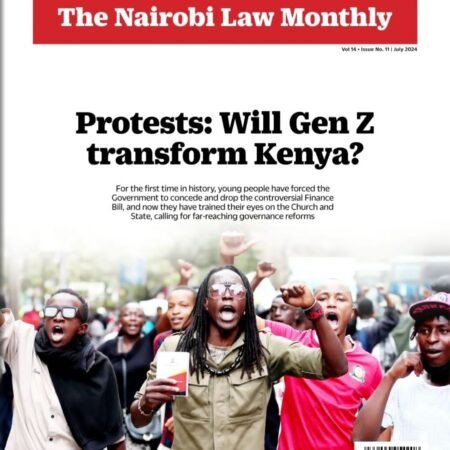Dr Charles A. Khamala
Despite 200 years of European capitalism, serious violent crime declined. That was attributable to three factors. First, because real threat of state criminal punishments deterred both repeat and potential deviants. Second, wealth redistribution by welfare states cushioned the “discontented majority”. Third, informal reciprocity maintained social controls. Similar relatively lower violent crime rates characterised post-independent countries than today. However, post-Cold War World Bank and IMF Structural Adjustment Programmes heralded globalisation. Donor conditionalities forced developing countries’ governments to downsize, and embrace economic liberalisation and privatisation.
-
Sale!
Download Nairobi Law Monthly Magazine July 2024 Edition
Downloads Original price was: KShs200.00.KShs100.00Current price is: KShs100.00.
In 2002, WHO reported that only 10 percent of all homicide-related deaths occurred in high-income countries. By contrast: “In African and Latin American regions, average homicides are over twice as high as in the rest of the world, although there are large national, ethnic, and age variations”. Curiously, following Saddam Hussein’s deposal, David Whyte (2007) says: “An unknown proportion of Iraqi oil revenue has disappeared into the pockets of contractors and fixers in the form of bribery, over-charging, embezzlement, and product substitution, bid-rigging and false claims. At least $12 billion (Sh1.2 trillion) of that revenue appropriated by the coalition regime [i.e. the Anglo-American government] has not been adequately accounted for”. Two questions emerge. One, whether or not the welfare state can continue to curtail criminogenic pressures for lower class violent crime, particularly in the Kenyan context within global market arrangements. Two, what the impact of corruption on both mundane and extraordinary crimes has been.
Capitalism and class struggle
Capitalism has its contradictions. Naturally, to survive, people must work. Yet it is artificial to buy things we do not need. Without cajoling, persuading, encouraging and convincing, no consumer would purchase overproduced things. “Shoppers” are primarily misled by commercial advertising. Unleashed media seduces gullible eyeballs with subliminal sights. Suggestive sounds whispered into earlobes whet appetites for non-essential commodities. Consumerism thus drives the capitalist economic train.
However, it is not possible for owners of capital to use their own labour-power to stoke the engines of mass production. Instead, supply-side working classes must somehow surrender to perform routine, boring and tiresome tasks in unpleasant and unhealthy conditions. Nor are workers ever paid the full dues of their efforts. Rather, lest the enterprise fold up, owners must retain and reinvest the bulk of all profits. Hence, most workers cannot even afford their own finished products. This is alienation. Because workers can withdraw their labour-power, there is hope. They can strike, go-slow or even, through boycotts, sabotage economic consumption. Industrial action saddles owners with onerous bank debts.
Another contradiction is that slavery, servitude or forced labour are debilitating and therefore self-defeating. Degrading human dignity accelerates rebellion. Protracted class struggle, between private factory owners paying the absolute minimum to workers who demand higher wages, is capitalism’s fundamental contradiction. To simmer these class conflicts, 17th century factory owners established the modern nation-state. It monopolises the use of force, labelled crime, in the name of preserving economic efficiency. William Chambliss (1975) concludes that the criminal law is the factory owner’s secondary tool, created to justify interference with workers, by punishing those who withhold labour or steal property.
For Nils Christie (2004), “Crime does not exist. Only acts exist, acts given different meanings within several social frameworks. Acts, and meanings given them, are our data. Our challenge is to follow the destiny of acts through the universe of meanings.
Particularly, what are the social conditions that encourage or prevent giving the act the meaning of being crime?” Lucia Zedner (2004) agrees that crime “is a problematic category used routinely to describe a set of behaviours that, beyond a central core, are highly contested. Legal definition alone cannot adequately recognise the historical development, social relationships, practices, ideologies, and interests that determine what, at any given moment, is designated criminal”.
Consider the socio-economic pressures behind last year’s belligerence by President Uhuru Kenyatta – rated by Forbes (2008) as Africa’s richest president with an estimated net worth of over $500 million (Sh50 billion) – using his executive powers to expressly defy an Employment and Labour Relations Court order. He wantonly disobeyed directions that the Teachers Service Commission must increase lowly-paid teachers’ salaries by 50-60 per cent. Compare it with a 2016 confidential status report by the Ethics and Anti-Corruption Commission showing that, of 200 people on the List of Shame the President unprecedentedly handed to Parliament a year ago, investigative or further action has been taken against 61 pc.
Some highly-paid individuals charged with corruption and abuse of office, include Kenyatta’s former Cabinet Secretary Charity Ngilu. She is out on bond of Sh1 million for charges of obstructing investigations into the Karen saga of double allocation of a 134-acre land parcel valued at Sh8 billion. She allegedly ordered her Land ministry officials to neither release evidentiary documents nor record statements with EACC. Her former Transport counterpart, Eng. Michael Kamau “is still facing charges over alleged loss of public funds during the tarmacking of Kamukuywa-Kaptama-Kapsokwony-Sirisia road”.
More recently, former Devolution Cabinet Secretary Anne Waiguru is under re-investigation for alleged involvement in misappropriating Sh791 million from the National Youth Service. Yet she hopes to unseat Evans Kidero as Nairobi governor at the next election. Mere suspicion and prosecutorial posturing aside, evidently, in Kenya too, suite criminals usually escape with sophisticated theft comprising corporate and occupational crimes.
Conversely, poor people routinely suffer death sentences for robbery with violence or murder, which invariably occur upon perpetrating or concealing street crimes such as burglary, robbery, assault or rape. Although Kenya’s capitalist criminal justice system perennially tolerates the ruling class’s motivation to corrupt their way to what Jock Young (1999) calls “bulimia”, the president’s 2017 election potential suddenly appears delicately predicated upon whether any corruption convictions – ruling party or opposition – eventually crystalise. Shall Kenyan voters short-circuit unequal criminal justice by adjudging a candidate’s development record or policy agenda, rather than recycling elites based on bribery-cum-ethnic extraction?
Electoral corruption
Another capitalism contradiction concerns intra-class competition for political power. Over time, the authoritative aura by which administrators appear to wield state power invariably disappears. Democracy sows its own seeds of electoral corruption. With workers constantly threatening to revolt against capital’s subjugation, repression through brute force becomes unsustainable. General elections present an efficient device to prevent overthrow of the ruling classes who manage state power for factory or farm owners. Once again, free media is co-opted, not merely to publicise mainstream agendas, but primarily to maximise exposure of ruling class personalities to the electorate. Facilitating mass participation in representational choices creates the impression that a worker’s failure to actualise him or herself is attributable personal laziness. In reality, elites conspire to reproduce exploitative social arrangements and legitimise not only widespread poverty, but also increasing inequality.
Sadly, Kenyan electoral law erects no ceiling on expenditure. Incapacity effectively excludes the poor from vying. This also leaves seats available for auction to anointed ethnic elites capable of vote-buying. That contradiction is starkly illustrated by recent shocking revelations implicating Governor Kidero in bribing Supreme Court Judge Philip Tunoi to dismiss Ferdinand Waititu’s election petition.
The Kenya Institute for Public Policy Research and Analysis (Kippra) would describe paying colossal figures to avoid by-election campaigning as “the opportunity cost, the cost of organising the ‘criminal firm’”. If true, it suggests that the Nairobi gubernatorial seat is valued at over $2-3 million (Sh 200-300 million). Comparatively, a successful Kenyan presidential candidate is required to receive not only 25 per cent of votes in at least half the 47 counties (all worth say Sh 3 billion), but also 50 + 1 of the national vote (equivalent to the price of a majority of the Senators, Governors, MPs, Women’s Reps and MCAs). Combining these two benchmarks, the presidency may thus be conservatively estimated at Sh10 billion…
Get yourself a copy of the magazine to continue reading this article…


